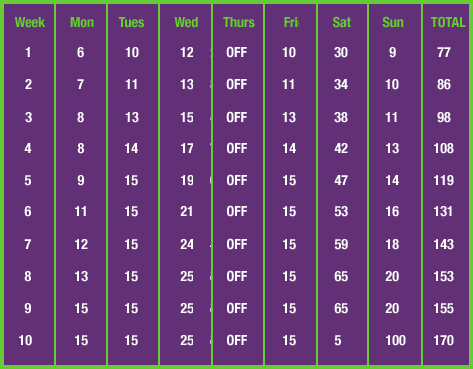 |
 |
 |
 |
 |
 |
 |
 |
|
|
|
||||||||
 |
Training
tips / Recovery / Nutritional / Climbing
and descending Training Tips on Riding a Century (100 miles or more) in One Day The following, taken from Long-Distance Cycling,
published by This
schedule can be started once you are accustomed
Use the following schedule if you have been riding 50-75 miles per week,
 |
|||||||
RETURN TO TOP OF PAGE |
||||||||
The goal is to increase your mileage by about 12 percent each week. Ride at the approximate pace you plan or hope to ride on the century ride. Buy a computer for you bike: a basic one will provide you with lots of“neat” biking information: current speed, average speed, odometer, trip odometer, time, stopwatch. They are very helpful in training as the “miles add up”. RECOVERING FROM TRAINING RIDES 2. Beware of over-training warning signals: chronic fatigue, elevated resting heart rate, weight loss, poor sleeping patterns, irritable disposition, aching legs or a lingering cold. 3. On a long ride pedal easily for the last ten miles or so to
warm down your muscles. NUTRITIONAL AND HEALTH TRAINING TIPS 1. Drink like a fish before, during, and after rides. (If you are not going to the bathroom at every pit stop, you are not drinking enough). Drink at least two water bottles (32 to 44 ounces) per hour in hot weather. On long rides, you need to replace electrolytes lost during the vigorous exercise. Use of Gatorade, Powerade or other “sports” drinks can help. The minerals (sodium, chloride, and potassium) are important for muscles to work effectively. Carry a water bottle around the office, home, garden, in the car. Become accustomed to always taking in fluids. Drink before you are thirsty and eat before you are hungry. It’s hard to recover once you “hit the wall” with regard to water and energy depletion and can be very dangerous. 2. Eat high-carbohydrate foods and increase the percentage of carbohydrates in the days before the big ride. Eat rice pudding, yogurt, muffins, whole-wheat cereal and toast, oatmeal and lots of pasta. You will build muscle and have reserve energy. 3. Use extra salt because you will lose a great deal of sodium when you sweat. 4. If your back is sore, raise the stem on your bike until its top is an inch or two below the top of the saddle. If you are prone to sore backs, strengthen abdominal muscles by doing ‘crunch’ sit-ups. 5. Stretch your neck before, during and after rides. Change the position as you ride. 6. On long rides, become skilled at eating while riding. Do no wait until you “feel” hungry because your body will have already depleted its energy reserve. Do not eat while riding in traffic, going down hill or (uphill which is very hard and dangerous to do) or when out of breath as the danger of choking increases. You may want to clear you nasal passages before eating because you will need to breathe through your nose while chewing. If you need to, spit out the food rather than choke if you need to focus all your attention on riding. CLIMBING AND DESCENDING HILLS Climbing Hills: 1- Do not sprint up hills thinking that you can “ ride over” as you will deplete your oxygen supply quickly, usually well short of the summit and your legs and lungs will have little left to get you to the top. It will also take a few minutes to “catch your breath” as you pedal down the road. 2- When climbing, use a gear you can turn at about 80 rpm (revolutions per minute). This will conserve energy and keep your pedaling cadence steady. Shift gears as your pedaling cadence slows. 3- On long hills stay seated to conserve energy, but you may want to stand to maintain speed, to use different muscles, but again beware of attacking the hill to fast. 4- Don’t grab the handlebar drops when climbing, as this will compress the diaphragm and inhibits breathing. Use the top part of the handlebar. Especially when standing on the pedals. Descending Hills: 1- On long descents, when the road is wet, maintain slight pressure on your brakes, which will help to keep the rims and break pads free from water and help with faster stopping 2- Continue to pedal slightly, to help keep your balance. Keep your bike in a “higher gear” (harder to pedal) so that you may be able to accelerate if needed. 3- Don’t ride the brakes hard for to long as too much heat may build up. If you can’t slow down relatively quickly you are probably going to fast. 4- Be particularly mindful of sand, gravel, puddles or road debris, as it is more difficult to control your bike at higher speeds. |
||||||||
